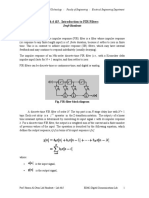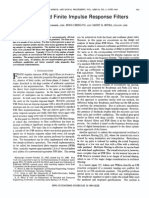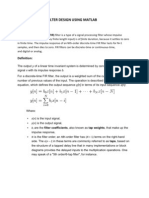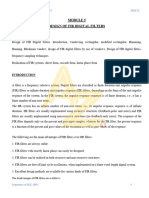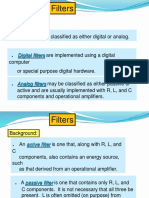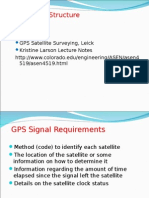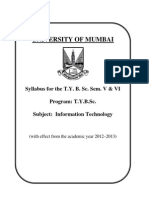Finite Impulse Response
Finite Impulse Response
Uploaded by
Yoga Putra PratamaCopyright:
Available Formats
Finite Impulse Response
Finite Impulse Response
Uploaded by
Yoga Putra PratamaOriginal Description:
Copyright
Available Formats
Share this document
Did you find this document useful?
Is this content inappropriate?
Copyright:
Available Formats
Finite Impulse Response
Finite Impulse Response
Uploaded by
Yoga Putra PratamaCopyright:
Available Formats
Finite impulse response
From Wikipedia, the free encyclopedia
In signal processing, a finite impulse response (FIR) filter is a filter whose impulse response (or response to any finite length input) is of finite duration, because it settles to zero in finite time. This is in contrast to infinite impulse response (IIR) filters, which may have internal feedback and may continue to respond indefinitely (usually decaying). The impulse response of an Nth-order discrete-time FIR filter (i.e., with a Kronecker delta impulse input) lasts for N + 1 samples, and then settles to zero. FIR filters can be discrete-time or continuous-time, and digital or analog.
Contents
[hide]
1 Definition 2 Properties 3 Impulse response 4 Filter design
4.1 Window design method
5 Moving average example 6 See also 7 References 8 External links
Definition [edit]
A discrete-time FIR filter of order N. The top part is an N-stage delay line with N + 1 taps. Each unit delay is a z1operator in Z-transform notation.
The output y of a linear time invariant system is determined by convolving its input signal x with its impulse response b.
For a discrete-time FIR filter, the output is a weighted sum of the current and a finite number of previous values of the input. The operation is described by the following equation, which defines the output sequence y[n] in terms of its input sequence x[n]:
where:
is the input signal, is the output signal, are the filter coefficients, also known as tap weights, that make up the impulse response, is the filter order; an th-order filter has terms on the right-hand side. The in
these terms are commonly referred to as taps, based on the structure of a tapped delay linethat in many implementations or block diagrams provides the delayed inputs to the multiplication operations. One may speak of a 5th order/6-tap filter, for instance.
Properties [edit]
An FIR filter has a number of useful properties which sometimes make it preferable to an infinite impulse response (IIR) filter. FIR filters:
Require no feedback. This means that any rounding errors are not compounded by summed iterations. The same relative error occurs in each calculation. This also makes implementation simpler.
Are inherently stable. This is due to the fact that, because there is no required feedback, all the poles are located at the origin and thus are located within the unit circle (the required condition for stability in a discrete, linear-time invariant system).
They can easily be designed to be linear phase by making the coefficient sequence symmetric; linear phase, or phase change proportional to frequency, corresponds to equal delay at all frequencies. This property is sometimes desired for phase-sensitive applications, for example data communications, crossover filters, and mastering.
The main disadvantage of FIR filters is that considerably more computation power in a general purpose processor is required compared to an IIR filter with similar sharpness or selectivity, especially when low frequency (relative to the sample rate) cutoffs are needed. However many digital signal processors provide specialized hardware features to make FIR filters approximately as efficient as IIR for many applications.
Impulse response [edit]
The impulse response
can be calculated if we set
in the above relation, where
is the Kronecker delta impulse. The impulse response for an FIR filter then becomes the set of coefficients , as follows
for
to
The Z-transform of the impulse response yields the transfer function of the FIR filter
FIR filters are clearly bounded-input bounded-output (BIBO) stable, since the output is a sum of a finite number of finite multiples of the input values, so can be no greater than times the largest value appearing in the input.
Filter design [edit]
To design a filter means to select the coefficients such that the system has specific characteristics. The required characteristics are stated in filter specifications. Most of the time filter specifications refer to the frequency response of the filter. There are different methods to find the coefficients from frequency specifications: 1. 2. 3. 4. Window design method Frequency Sampling method Weighted least squares design Parks-McClellan method (also known as the Equiripple, Optimal, or Minimax method). The Remez exchange algorithm is commonly used to find an optimal equiripple set of coefficients. Here the user specifies a desired frequency response, a weighting function for errors from this response, and a filter order N. The algorithm then finds the set of coefficients that minimize the maximum deviation from
the ideal. Intuitively, this finds the filter that is as close as you can get to the desired response given that you can use only coefficients. This method is
particularly easy in practice since at least one text[1] includes a program that takes the desired filter and N, and returns the optimum coefficients.
5.
Equiripple FIR filters can be designed using the FFT algorithms as well.[2] The algorithm is iterative in nature. You simply compute the DFT of an initial filter design that you have using the FFT algorithm (if you don't have an initial estimate you can start with h[n]=delta[n]). In the Fourier domain or FFT domain you correct the frequency response according to your desired specs and compute the inverse FFT. In time-domain you retain only N of the coefficients (force the other coefficients to zero). Compute the FFT once again. Correct the frequency response according to specs.
Software packages like MATLAB, GNU Octave, Scilab, and SciPy provide convenient ways to apply these different methods. Some filter specifications refer to the time-domain shape of the input signal the filter is expected to "recognize". The optimum matched filter for separating any waveform from white noise is obtained by sampling that shape and using those samples in reverse order as the coefficients of the filter giving the filter an impulse response that is the time-reverse of the expected input signal.
Window design method [edit]
In the Window Design Method, one designs an ideal IIR filter, then applies a window function to it in the time domain, multiplying the infinite impulse by the window function. This results in the frequency response of the IIR being convolved with the frequency response of the window function. If the ideal response is sufficiently simple, such as rectangular, the result of the convolution can be relatively easy to determine. In fact one usually specifies the desired result first and works backward to determine the appropriate window function parameter(s). Kaiser windows are particularly well-suited for this method because of their closed form specifications.
Moving average example [edit]
Fig. (a) Block diagram of a simple FIR filter (2nd-order/3-tap filter in this case, implementing a moving average)
Fig. (b) Pole-Zero Diagram
Fig. (c) Amplitude and phase responses
A moving average filter is a very simple FIR filter. It is sometimes called a boxcar filter, especially when followed by decimation. The filter coefficients, following equation: , are found via the
To provide a more specific example, we select the filter order:
The impulse response of the resulting filter is:
The Fig. (a) on the right shows the block diagram of a 2nd-order movingaverage filter discussed below. To discuss stability and spectral topics we take the z-transform of the impulse response:
Fig. (b) on the right shows the pole-zero diagram of the filter. Zero frequency (DC) corresponds to (1,0), positive frequencies advancing counterclockwise around the circle to (-1,0) at half the sample frequency. Two poles are located at the origin, and two zeros are located at , .
The frequency response, for frequency in radians per sample, is:
Fig. (c) on the right shows the magnitude and phase plots of the frequency response. Clearly, the moving-average filter passes low frequencies with a gain near 1, and attenuates high frequencies. This is a typical low-pass filter characteristic. Frequencies above arealiases of the frequencies below , and are generally ignored or filtered out if reconstructing a continuous-time signal. The following figure shows the phase response. Since the phase always follows a straight line except where it has been reduced modulo radians (should be 2), the linear phase property is demonstrated.
You might also like
- 1.finite Impulse Response (FIR) FiltersDocument16 pages1.finite Impulse Response (FIR) FiltersSamet YılmazNo ratings yet
- Lab.4&5. FIR FiltersDocument7 pagesLab.4&5. FIR FiltersKen MutaiNo ratings yet
- Lab.4&5. FIR FiltersDocument7 pagesLab.4&5. FIR Filtersآيـة جمال عبد الفتاح الراويNo ratings yet
- Finite Impulse Response (Fir) : ObjectivesDocument9 pagesFinite Impulse Response (Fir) : ObjectivesAldon JimenezNo ratings yet
- Digital Filter: Sinusoidal ResponseDocument3 pagesDigital Filter: Sinusoidal ResponseAltaf HussainNo ratings yet
- 5filter Design EquilizationDocument11 pages5filter Design EquilizationharithNo ratings yet
- Class Notes - Digital Filters For Numerical RelayDocument4 pagesClass Notes - Digital Filters For Numerical RelaybiswajitsahooNo ratings yet
- Dspa Word FileDocument82 pagesDspa Word FilenithinpogbaNo ratings yet
- Dit 705 - DSP - 4Document35 pagesDit 705 - DSP - 4fydatascienceNo ratings yet
- Chapter 10Document8 pagesChapter 10Aldon JimenezNo ratings yet
- Fir Filters ReportDocument8 pagesFir Filters ReportGaneshVenkatachalam100% (1)
- Notch Filter DigitalDocument43 pagesNotch Filter Digitalanand248No ratings yet
- Q.Explain Aliasing Concept With ExampleDocument15 pagesQ.Explain Aliasing Concept With ExampleManvita MoreNo ratings yet
- M2 and M3 MaterialsDocument10 pagesM2 and M3 MaterialsB NikethNo ratings yet
- Digital Filter - WikipediaDocument27 pagesDigital Filter - WikipediaanntreesajoeNo ratings yet
- Parallel FiltersDocument5 pagesParallel FiltersAdi PopaNo ratings yet
- On Room Correction PDFDocument12 pagesOn Room Correction PDFAnthony HubbardNo ratings yet
- Study of FIR Filter Design Using Window Method: Lowpass and Highpass FilterDocument14 pagesStudy of FIR Filter Design Using Window Method: Lowpass and Highpass Filtervarsharaj575No ratings yet
- Filter: Filter Signal Processing Statistics Applied MathematicsDocument5 pagesFilter: Filter Signal Processing Statistics Applied MathematicsJiiva RajeshNo ratings yet
- University of Kentucky: EE 422G - Signals and Systems LaboratoryDocument5 pagesUniversity of Kentucky: EE 422G - Signals and Systems Laboratoryamina sayahNo ratings yet
- Experiment 6 Implementation of LP Fir Filter For A Given SequenceDocument25 pagesExperiment 6 Implementation of LP Fir Filter For A Given SequenceSrinivas SamalNo ratings yet
- What Is FilteringDocument17 pagesWhat Is FilteringShoaib RathoreNo ratings yet
- Fir-Iir Filters Viva-Questions PDFDocument5 pagesFir-Iir Filters Viva-Questions PDFSigra JisawNo ratings yet
- Interpolated FIR Filter (MITRA)Document8 pagesInterpolated FIR Filter (MITRA)Brandon HerreraNo ratings yet
- Digital Filteration of ECG Signals For Removal of Baseline DriftDocument5 pagesDigital Filteration of ECG Signals For Removal of Baseline DriftSeema SinglaNo ratings yet
- 2Document26 pages2Siji VargheseNo ratings yet
- Lec 1Document18 pagesLec 1Aziz ul haqNo ratings yet
- FIR FiltersDocument31 pagesFIR FiltersPaul The HumanNo ratings yet
- Lab.6&7. IIR FiltersDocument8 pagesLab.6&7. IIR FiltershimNo ratings yet
- Diseño de Filtros IIR y FIRDocument11 pagesDiseño de Filtros IIR y FIRacajahuaringaNo ratings yet
- DSP Part A Question and AnswerDocument17 pagesDSP Part A Question and Answer21wj1a04a0No ratings yet
- FIR & IIR Filters DesignDocument12 pagesFIR & IIR Filters DesignPreeti KatiyarNo ratings yet
- Digital Signal Processing Imp QuestionsDocument10 pagesDigital Signal Processing Imp QuestionsKranthi Mahesh ReddyNo ratings yet
- Lab 5. FIR & IIR Filters in Matlab: Filter DesignDocument12 pagesLab 5. FIR & IIR Filters in Matlab: Filter DesignDrakshayaniMurgodNo ratings yet
- FirDocument4 pagesFirAhmed HussainNo ratings yet
- EE3001 - Advanced Measurements: Digital FiltersDocument38 pagesEE3001 - Advanced Measurements: Digital Filterssiamae100% (1)
- Signal Processing - Digital Filters - Wikibooks, Open Books For An Open WorldDocument6 pagesSignal Processing - Digital Filters - Wikibooks, Open Books For An Open WorldrockwellNo ratings yet
- An Economical Class of Digital Filters For Decimation and Interpolation (El Que Propuso Este Filtro)Document8 pagesAn Economical Class of Digital Filters For Decimation and Interpolation (El Que Propuso Este Filtro)guillermofioberaNo ratings yet
- Digital Design of Filters (FIR,IIR) -part1 ايادDocument19 pagesDigital Design of Filters (FIR,IIR) -part1 ايادMohammed YounisNo ratings yet
- Filter ApproximationDocument3 pagesFilter ApproximationpalmerxNo ratings yet
- Module 5-FIR Filter Design-DSP-Jun2022Document41 pagesModule 5-FIR Filter Design-DSP-Jun2022Dimple BNNo ratings yet
- 18ee63 DSP Module-3Document19 pages18ee63 DSP Module-3Appasabgouda BiradarNo ratings yet
- BMSPDocument20 pagesBMSPnaveen991606No ratings yet
- Design and FPGA Implementation of Variable FIR Filters Using The Spectral Parameter Approximation and Time-Domain ApproachDocument5 pagesDesign and FPGA Implementation of Variable FIR Filters Using The Spectral Parameter Approximation and Time-Domain ApproachRahul SharmaNo ratings yet
- Fir Filter Design Using MatlabDocument6 pagesFir Filter Design Using MatlabRashed Hossain MirajNo ratings yet
- 4 - Difference Equations and Filtering - Week 5Document41 pages4 - Difference Equations and Filtering - Week 5renatto.guiusseppe.peraltaNo ratings yet
- Project On Wireless CommunicationDocument16 pagesProject On Wireless CommunicationAkshat SharmaNo ratings yet
- GG313 Lec 27Document16 pagesGG313 Lec 27wanted247No ratings yet
- Performance Analysis of FIR Filter Algorithm and Architecture To Design A Programmable Pre-Modulation Filter For Avionic ApplicationDocument5 pagesPerformance Analysis of FIR Filter Algorithm and Architecture To Design A Programmable Pre-Modulation Filter For Avionic ApplicationSayeed HabeebNo ratings yet
- Average FilteringDocument22 pagesAverage Filtering7204263474No ratings yet
- ECE-S 631: Fundamentals of Deterministic DSP: Prof. John WalshDocument21 pagesECE-S 631: Fundamentals of Deterministic DSP: Prof. John WalshPhuc PhamNo ratings yet
- Transfer Function Digital FiltersDocument4 pagesTransfer Function Digital Filterscharanf22No ratings yet
- Infinite Impulse ResponseDocument126 pagesInfinite Impulse ResponseLe BinhNo ratings yet
- FIR Filter BasicsDocument26 pagesFIR Filter BasicsdkishoreNo ratings yet
- Question Bank ITDocument20 pagesQuestion Bank ITSreejith GopiNo ratings yet
- DSP Mod5@Azdocuments - inDocument20 pagesDSP Mod5@Azdocuments - inAnn mary GonsalvezNo ratings yet
- Filter Bank: Insights into Computer Vision's Filter Bank TechniquesFrom EverandFilter Bank: Insights into Computer Vision's Filter Bank TechniquesNo ratings yet
- Adaptive Filter: Enhancing Computer Vision Through Adaptive FilteringFrom EverandAdaptive Filter: Enhancing Computer Vision Through Adaptive FilteringNo ratings yet
- Some Case Studies on Signal, Audio and Image Processing Using MatlabFrom EverandSome Case Studies on Signal, Audio and Image Processing Using MatlabNo ratings yet
- JonCarrier Dither Presentation FinalDocument14 pagesJonCarrier Dither Presentation FinalAdrian BottomleyNo ratings yet
- Experiment 2 Mat LabDocument4 pagesExperiment 2 Mat LabKapil GuptaNo ratings yet
- Filter Banks Using WaveletsDocument26 pagesFilter Banks Using WaveletsKaustubh VenkateshNo ratings yet
- Auralization Applying The Parametric Room Acoustic Modeling Technique - The Diva Auralization SystemDocument6 pagesAuralization Applying The Parametric Room Acoustic Modeling Technique - The Diva Auralization SystemLucianaNo ratings yet
- CH-1 On DSP, Digital Signal ProcessingDocument19 pagesCH-1 On DSP, Digital Signal ProcessingGUIDE ON BIO-MEDICAL ENGINEERING UNDERGRADUATE PROGRAM:No ratings yet
- Basics of Analog-To-digital ConvertionDocument9 pagesBasics of Analog-To-digital ConvertionThanh Nhan LeNo ratings yet
- 142195-1 XLS3 Service Manual 4-2010Document94 pages142195-1 XLS3 Service Manual 4-2010selfmake1523No ratings yet
- Unit 4Document40 pagesUnit 4Rupali KuteNo ratings yet
- Assignment 2Document2 pagesAssignment 2daghanunalNo ratings yet
- Stereo Vision Images Processing For Real-Time Object Distance and Size MeasurementsDocument5 pagesStereo Vision Images Processing For Real-Time Object Distance and Size MeasurementseProcurement Reviewer1No ratings yet
- Digital Signal Processing (DSP) LAB Lab Report#05: SubjectDocument10 pagesDigital Signal Processing (DSP) LAB Lab Report#05: SubjectUprising RivalsNo ratings yet
- Tutorial Signal ProcessingDocument3 pagesTutorial Signal ProcessingeerkmeenaNo ratings yet
- Fourier Series of Periodic Discrete-Time SignalsDocument36 pagesFourier Series of Periodic Discrete-Time SignalsBruce MarshallNo ratings yet
- Atme College of Engineering: Lab ManualDocument44 pagesAtme College of Engineering: Lab ManualGangadhar MNo ratings yet
- EECE 301 Signals & Systems: Prof. Mark FowlerDocument12 pagesEECE 301 Signals & Systems: Prof. Mark FowlerahmdNo ratings yet
- BTP Presentation - Anurag GoyalDocument21 pagesBTP Presentation - Anurag GoyalSamarthNo ratings yet
- A Matlab Tour of Morphological Filtering: EE465: Introduction To Digital Image Processing 1Document20 pagesA Matlab Tour of Morphological Filtering: EE465: Introduction To Digital Image Processing 1Isa MahfudiNo ratings yet
- University Question Bank PDFDocument16 pagesUniversity Question Bank PDFlathavenkyNo ratings yet
- GPS SignalsDocument23 pagesGPS SignalsDheerajKaushal100% (1)
- تقرير dsp قيد الانشاءDocument2 pagesتقرير dsp قيد الانشاءAbadiNo ratings yet
- Edge Detection & ThresholdingDocument29 pagesEdge Detection & ThresholdingGopi ChandNo ratings yet
- Embedded Systems: Calibration Instruments LaboratoryDocument12 pagesEmbedded Systems: Calibration Instruments LaboratoryAlsacia PixNo ratings yet
- Chapter 3 Difference EquationDocument33 pagesChapter 3 Difference EquationMaga LakshmiNo ratings yet
- TYIT New SyllabusDocument26 pagesTYIT New SyllabusImtishal Ali0% (1)
- Underwater Wireless CommunicationDocument9 pagesUnderwater Wireless CommunicationsayaleeNo ratings yet
- Ipmv NotesDocument125 pagesIpmv Notessniper x4848 PillaiNo ratings yet
- Labs-TE Lab Manual DSPDocument67 pagesLabs-TE Lab Manual DSPAntony John BrittoNo ratings yet
- DSP Lab - 15ecl57 Part - IDocument37 pagesDSP Lab - 15ecl57 Part - Ivsuresha25% (4)
- VT DSO 2810 Manual PDFDocument40 pagesVT DSO 2810 Manual PDFFolpoNo ratings yet

